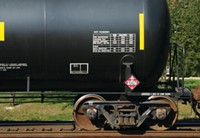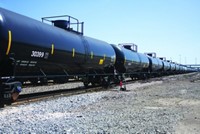Advertisement
Grab your lab coat. Let's get started
Welcome!
Welcome!
Create an account below to get 6 C&EN articles per month, receive newsletters and more - all free.
It seems this is your first time logging in online. Please enter the following information to continue.
As an ACS member you automatically get access to this site. All we need is few more details to create your reading experience.
Not you? Sign in with a different account.
Not you? Sign in with a different account.
ERROR 1
ERROR 1
ERROR 2
ERROR 2
ERROR 2
ERROR 2
ERROR 2
Password and Confirm password must match.
If you have an ACS member number, please enter it here so we can link this account to your membership. (optional)
ERROR 2
ACS values your privacy. By submitting your information, you are gaining access to C&EN and subscribing to our weekly newsletter. We use the information you provide to make your reading experience better, and we will never sell your data to third party members.
Safety
Railroads Ask Congress To Limit Financial Risk
Chemical industry opposes liability cap for rail shipment of hazardous materials
by Glenn Hess
June 14, 2006
Declaring that the existing environment for transporting hazardous materials is "untenable," the nation's railroads are asking Congress to either provide the industry with liability limits or eliminate its federal mandate to carry chlorine, ammonia, and other toxic substances.
"The railroad industry cannot continue to transport highly hazardous material under the conditions that currently exist," Association of American Railroads (AAR) President Edward R. Hamberger told the House Transportation & Infrastructure Committee's Railroads Subcommittee on June 13.
"The inordinately high risks now shouldered by the railroads must be dramatically reduced through improved safety and the provision of reasonable liability protection," Hamberger asserted.
If the financial risks are not reduced, he said, Congress should relieve railroads of the requirement to carry toxic chemicals and other highly hazardous substances. "Railroads should be permitted to decide for themselves whether to accept, and at what price they are willing to accept, such materials for transportation," Hamberger testified.
Under the Interstate Commerce Act, railroads have a "common carrier obligation," which means they are required by federal law to provide rates and service upon request by any shipper.
Although rail accidents involving hazardous materials are rare, Hamburger said, the insurance industry is unwilling to insure railroads against the "multi-billion-dollar risks" associated with such shipments. He added that railroads can suffer enormously costly judgments, "even for accidents where no one gets hurt and the railroads do nothing wrong."
Railroads face this risk in just a tiny fraction of their business, Hamberger told the panel. He said toxic chemicals and other hazardous commodities constitute only 0.3% of total carloads, but account for 50% of the industry's total insurance cost.
However, Martin J. Durbin, managing director of federal affairs for the American Chemistry Council, said chemical shippers are concerned that efforts by the railroads to alter the basic liability rules that govern hazardous materials transportation "are driving us down the wrong track."
Durbin said the current regulatory system "appropriately places legal liability on the party or parties that are responsible for an incident. Railroads, as well as hazardous materials shippers, should continue to bear liability for their own actions."
Removing that liability, or shifting it to the federal government or other private parties, could have "unforeseen and undesirable consequences," Durbin said. "Indeed, our concern is that such a change could erode safety performance by the carriers and create a significant disincentive to address the many factors that add up to hazardous materials transportation safety."
Rep. Steven C. LaTourette (R-Ohio), who chairs the Railroads Subcommittee, said he would explore options for reducing the financial risk to railroads when they carry hazardous commodities. He noted that insurance coverage is both expensive and limited in availability.
"Most railroads are only able to insure a fraction of their net worth. For a smaller carrier, a single hazmat accident might force the company into bankruptcy," he said.
LaTourette pointed out that liability for accidents involving nuclear material is limited by the Price-Anderson Act. "Perhaps a similar system should be established for hazmat," he said. "Other alternatives might be a federal liability compensation fund, a national wrap-up insurance program, or perhaps even a tort cap."




Join the conversation
Contact the reporter
Submit a Letter to the Editor for publication
Engage with us on Twitter